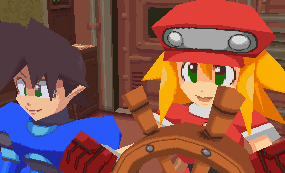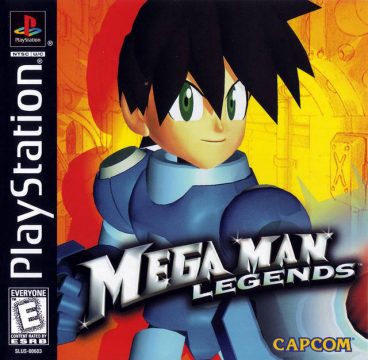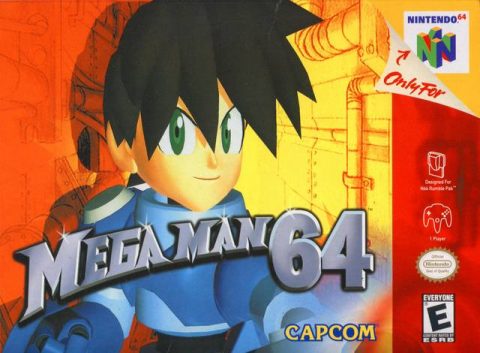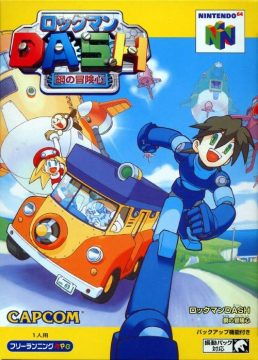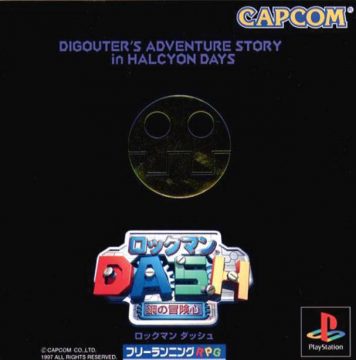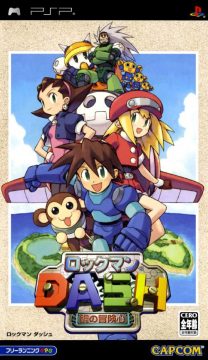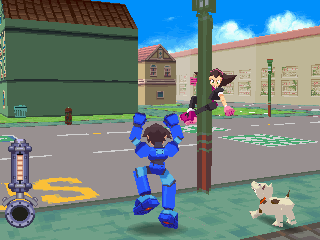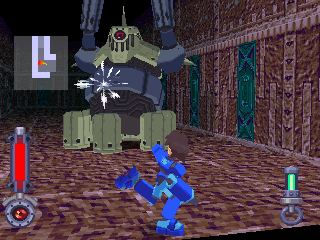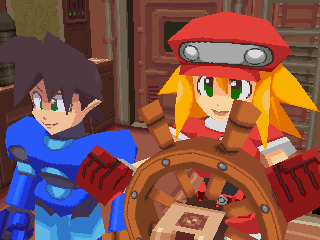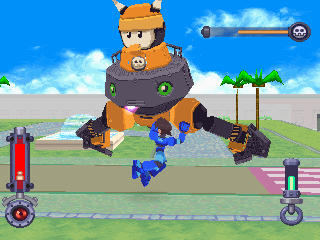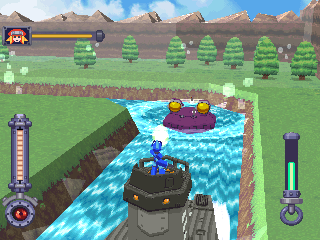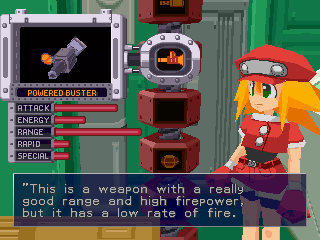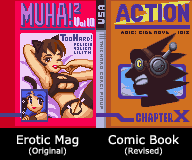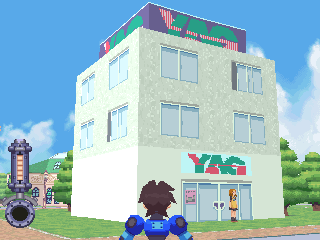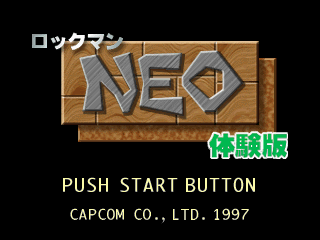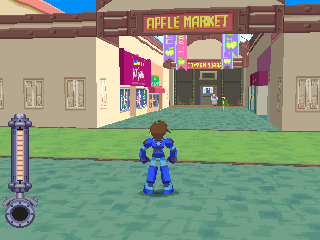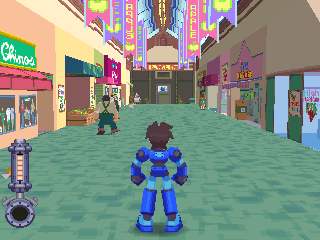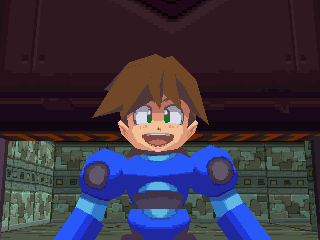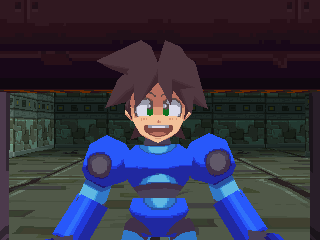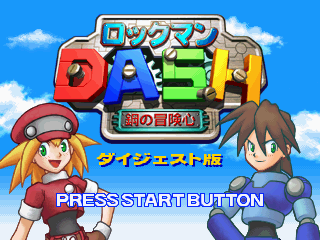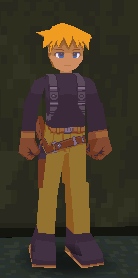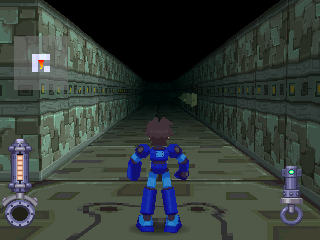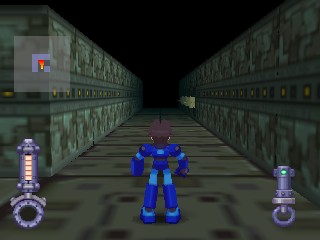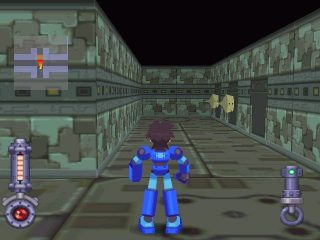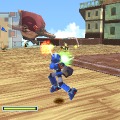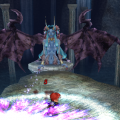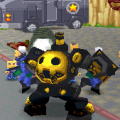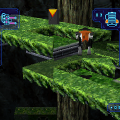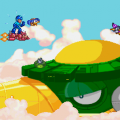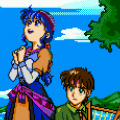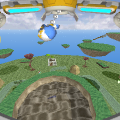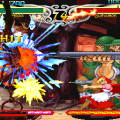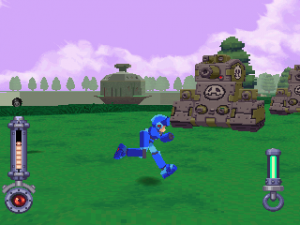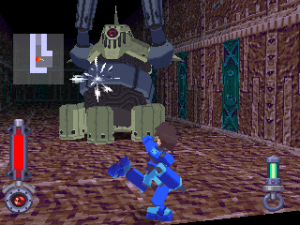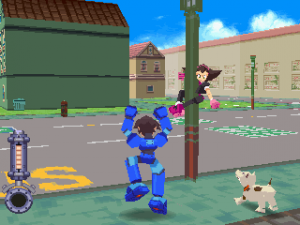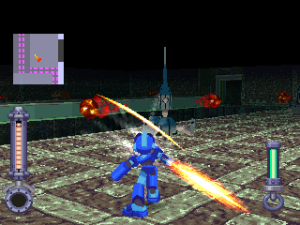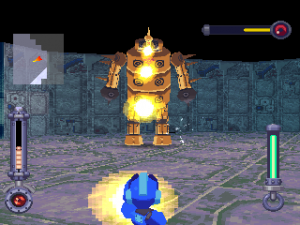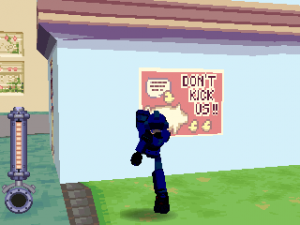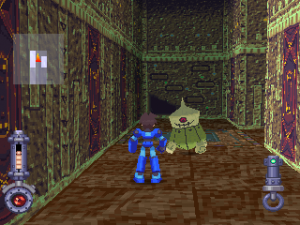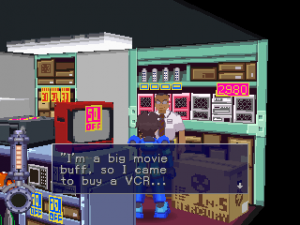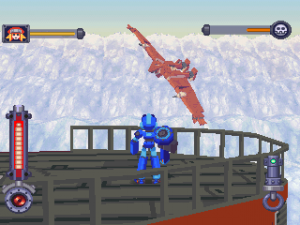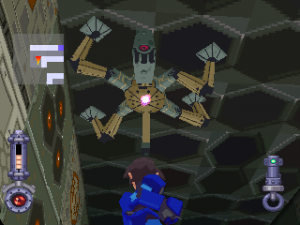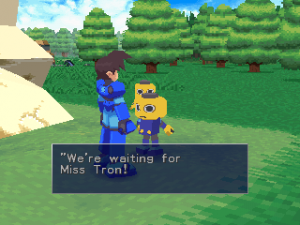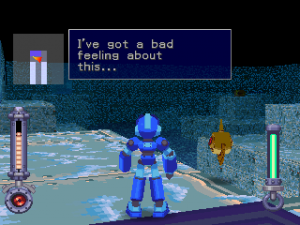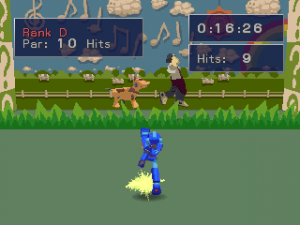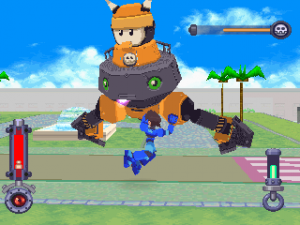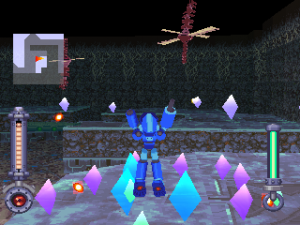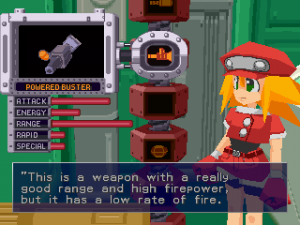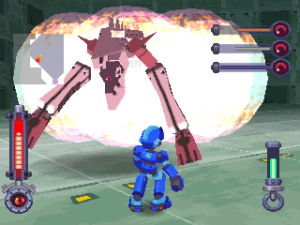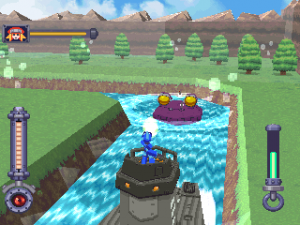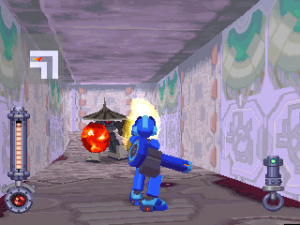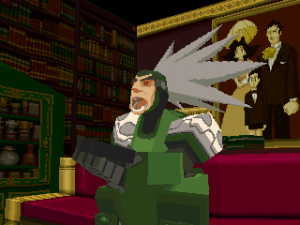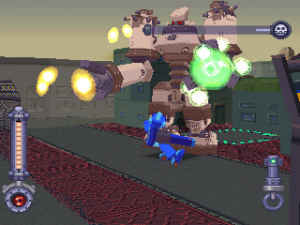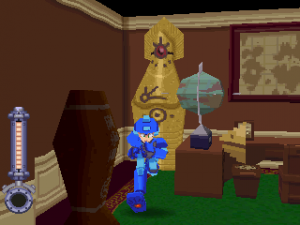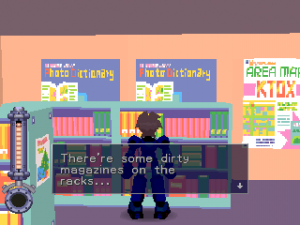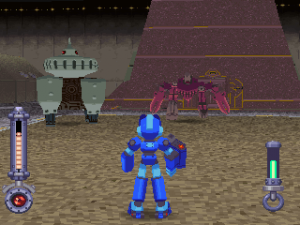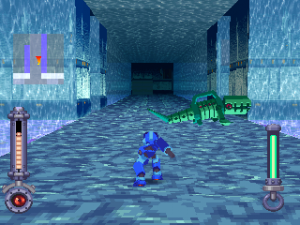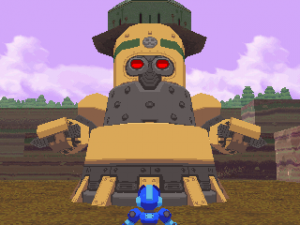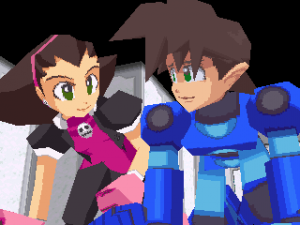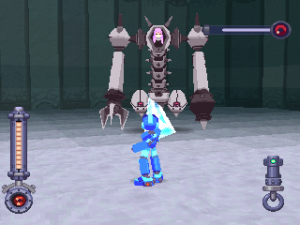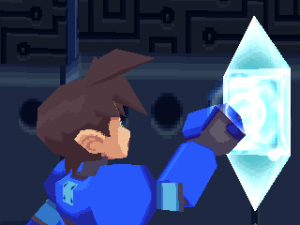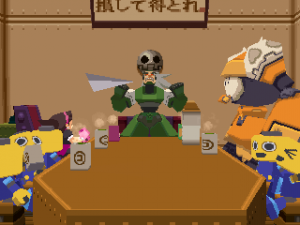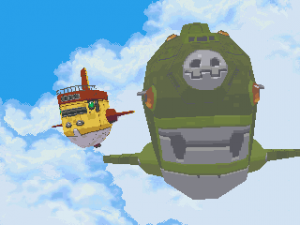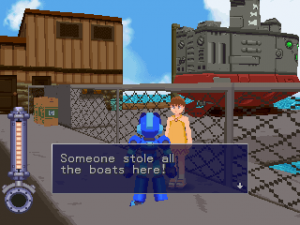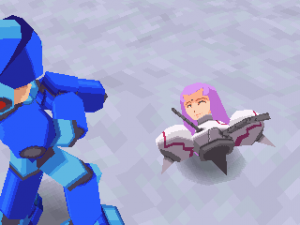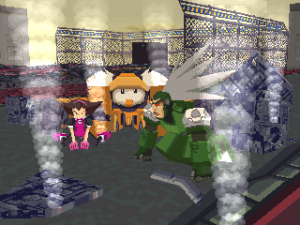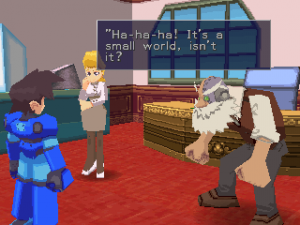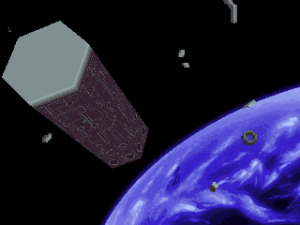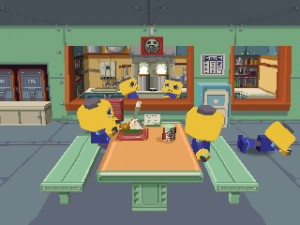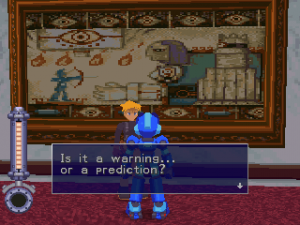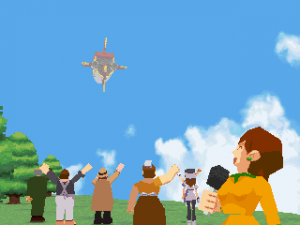The 5th generation of video games was a transitional period for the medium. For years leading up to the 32- and 64-bit age, technological advancement and programming know-how had strove to shift games past a plane consisting of merely two axses, and by the end of 1996 every major platform had a polygonal title to showcase how 3D gameplay can be done. Once the landmark title Super Mario 64 shook the gaming public at large, 2D and sprites in general became passé. Suddenly every classic franchise had to make the jump to the third dimension in order to stay relevant. Regrettably, much like many actors from the silent film era after the advent of “talkies”, few could survive that transition. It wasn’t just due to aesthetics (though 3D prowess of the time may have left something to be desired compared to sprite art of the later 16-bit variety), but issues with converting a game franchise’s gameplay to that new open dimensionality. Too often the concise framework and trappings of a great 2D title gets lost expanding it with a Z-axis, or the end result becomes retooled enough that the original charm is flat-lined, or perhaps the struggle of a functioning camera in 3D space is too much of a hassle (the latter issue still plaguing video games to this day). Regardless, the cutthroat business forced IPs to evolve or die in the wake of the next generation, and thus casualties were rampant — or at least left many out of commission until the luster of newfangled 3D had faded.
By all accounts, a 3D Mega Man game would be terrible. Judging by how Mega Man X7 turned out, this hypothesis does prove to be true. All that running and gunning gets muddied when threats can come after you at all sides, and the wonderfully tight level design would have to become compromised in order to make it easier to grasp and view it within the new dimension. But Sony, for a time, was very anti-2D for the most part, as they wanted to focus on bringing the future of games with their polygon-pushing console. While they did allow for the sprite-based 2D Mega Man 8 to be on their PlayStation due to brand recognition alone, and would host three Mega Man X titles later on, there came added pressure to pump out a 3D Mega Man title for the system as a concession. How would Capcom create classic Mega Man gameplay that would break through the proverbial polygonal ceiling?
Short answer: They didn’t. What became the first Mega Man Legends game was created with the express purpose to be an entirely different Blue Bomber outing.
The game begins in media res inside a spire alone in the vast sea. In Raiders of the Lost Ark fashion, Mega Man has sprung a trap after plucking a large Refractor from a pedestal and has to dive under closing doors to escape (with no helmet to comically grasp for). Once players are in control, the ocean steeple serves as a simple tutorial dungeon before setting the events proper for the main stage of exploration on the nearby Kattelox Island.
It is within this tower protruding high above the waves that players are flung into and forced to tangle with the main concern of the Legends series, sink or swim. Volnutt controls like a stiff tank, a far removal from the sublime freedom of all-directional movement granted in the earlier-released Super Mario 64. This is, in large part, no thanks to the platform of choice. Being developed in a pre-Dual Shock PS1 era, the player is stuck with only the D-pad and L1 & R1 buttons to move, turn, and strafe. This clunky way of maneuvering makes it difficult to veer left and right, as turning Mega Man is a slow procedure, especially from a stand-still. Using a mixture of strafing and turning can speed up the process, even allowing a quick 180, but Volnutt is nowhere near as fluid or nimble as his 2D counterparts. Despite a pokey rotation speed, Mega Man runs at a constant jog that can only be slowed by holding Circle. This walk speed is only enforced in one early segment to get past kids blocking a door, but the theory is that a tiptoing Mega Man might be able to sneak past Reaverbots, in theory. R2 serves as a nice lock-on for enemies so you won’t have to worry about positioning yourself just to land a shot.
It’s a noble effort since Legends‘ lock-on predates the release of the Z-targeting of Ocarina of Time by almost a year, yet in practice it functions far differently than Zelda’s. Targeting foes in MML freezes Mega Man in place, making it better for sniping faraway baddies or hard-to-reach upper and lower threats than any form of close-combat. In general, circle-strafing Reaverbots– or merely shooting from the hip and performing a rolling dodge if there’s little room– is the quicker and safer option offensively and defensively. No matter the control scheme though, collecting Refractor shards and energy cells that burst from defeated enemies is a bothersome task of running around and scrambling to gather as much as you can before they flicker out of existence. Either way, once you’ve run laps around the big-but-damaged one-armed Hanmuru Doll boss at the end of the sea tower ruins, you should be able to navigate throughout the rest of the game and handle a majority of the threats well enough.
Not long after escaping the spire with the big Blue Refractor, Mega Man and co.’s sunfish-shaped airship known as the Flutter sputters out, its rickety engine worn from age. They crash land on Kattelox Island and spend the entire trip searching for a way to get their ship back into flight-worthy shape, all while uncovering mysteries and capers along the way. The island is circular in shape, carved along the rim by crater chunks, but still large enough to house a bustling city with districts and marketplaces along with surrounding forest and an expansive lake. However, like an iceberg, the above ground of Kattelox is dwarfed by the interconnected maze of subterranean ruins. The maze of catacombs are said to house a treasure trove of high-quality Refractors, possibly the Mother Lode itself. Diggers are few in number amongst the townsfolk, so don’t expect much human company underground.
The island also hosts a dismal history. As the mayor, the library, and citizens will attest, signs point to multiple past civilizations rising and mysteriously vanishing on Kattelox, including a rusted out industrial section of the city merely 100 years old that’s only currently populated with a few utility workers and wild dogs. Fears of a legendary curse on the island keep many potential Diggers from access to the ruins without high-level licenses. Despite all that, Kattelox City thrives with many sights within its districts: a TV station, the aforementioned library, clothing stores, CD shop, shipping yard, upscale housing, a hospital, game development studio, and even a toy store selling — what else? — the hottest new video game Mega Man Legends. Right after being permitted into the city, there’s plenty of buildings to peruse and people to chat with before the next boss battle commences.
Throughout the game the Bonnes will be an ever-present thorn in Mega Man’s side. A large bulk of the bosses consist of a Bonne member, Servbot, or a combination manning a mech/tank/ship of Tron’s design and wreaking havoc on the island in a vain search for treasure before focusing efforts of laying waste to their blue menace in a personal vendetta. The pirate family can potentially create large scale damage to the island and city, leaving Volnutt with a hefty repair bill if he chooses to rebuild the destruction caused. Despite some leveled buildings and an excavated quarry surrounding a sub-gate to the underground, no serious harm befalls the citizens from the pirate attacks. The only serious threat to Kattelox looms underneath the surface as Mega Man peels back the veil of lost findings and keys to gates leading to lost desolate pockets of civilization once inhabitied by “Prototype Anthro Units”– predecessors to modern Carbons. This forgotten layer of the island also house a mainframe of an ancient security measure and populace control protocol.
Though it is possible for Mega Man can be a total dick during the adventure and cause his own ruckus, should you so choose. Hinted at deep inside the row of books in the library, Legends has a rudimentary morale system colored and reflected via his appearance where Volnutt can be a good or mean boy through his actions, and not just in plain dialogue trees. Along with simply playing through the regular missions, you can pay for the damages to the city, offer gifts to Roll, solve crimes for the police, help a pregnant woman, even help a sick girl walk again to create a better standing in the city. Such good acts make your suit shine a more vivid cerulean hue. Likewise, you can kick cans into shops, destroy vending machines, fire at news airships, run off with stolen money from a bank heist, or just criticize a local artist’s latest painting to turn into a dark armored jerk. However, in the first game at least, your moral choices doesn’t carry too much weight as it merely change some of the incidental dialogue from the NPCs, either praising or scorning you. Still, it’s better to do the right thing as fulfilling nice deeds grants Mega Man access to more items.
The items and weaponry found in the game are found differently than from Mega Man norm. Special weapons are not won from bosses, but found as junk or pieces waiting to be found inside chests or inside holes in the walls within the ruins, or offered from townsfolk for helping them out. These items on their own aren’t much good, but when handed to Roll can be merged together to make new arm attachments for Mega Man, which can be upgraded to perform even better so long as he has enough Zenny to pay for the enhancements. These weapon attachments cannot be switched on the fly, so you’d have to run to or call for Roll above ground in order to change them out. Like many Mega Man games, these weapons are not created equal, as running with and upgrading the Machine Gun attachment will get the job done majority of the time, while lobbing grenades or dropping mines is situational at best. Another example is the Vacuum Gun, which is perfect for drawing in hard-to-gather Refractor shards and health pickups, but useless for fights. The Drill attachment is one of the only weapon able to break through cracked walls and open up and link the entire underground, but is too short ranged to use for most battles. Should you have the time and money to beef up the Active Buster or Shining Laser, you’ll be able to bowl over any threat with ease. Both only become available after filling out side-quests late in the game, and their upgrade costs make them a grind-fest to max out. Aside from weapons, though, there are items to buy in the junk store or for Roll to create that serve to upgrade Mega Man himself a la from the X series; giving him a helmet, better armor, more life, higher jumping, and speedy roller skate shoes. Even the equivalent of E-Tanks make their appearance in refillable canteens you can purchase and expand in size.
The difficulty feels rather front-loaded. The first real boss battles (or missions, as the game calls them) happen in sequence one right after another while you’re still rather weak and stuck with one close-range mine special weapon. Considering your speed and performance in the first tetra of Bonne battles measures how much collateral damage you’d have to pay for, it can cause quite a blow to your funds if you’re not at least powered up from the junk store or fully accustomed to circle-strafing. Even then, the scrambling to tackle new dropped-in tanks while defending the mayor’s office can be frustrating when trying to keep building demolition at minimal. At least Data is available midway and offers items if you ask for assistance nicely. The construction Marwolf battle is also a bit of a challenge as it comes soon after the initial gauntlet if you choose not to allot more time to beef up. It is also one of the few fights that isn’t a mere strafe-and-shoot affair. After running through a fleet of Servbot-controlled tanks, Mega Man has to climb up onto the excavated quarry cliffs while dodging blasts to wait for the exact moment to hop onto the mecha and blast its door weak point. Get knocked off (still rather easy to do if you didn’t go back and made Roll create the helmet), you’d have to climb back up again for another chance to leap back on. It’s almost like a Shadow of the Colossus boss battle years before the fact, and with quirkier tank controls to land precise jumps.
Aside from the first missions, the rest of the game isn’t too terribly difficult once you get the controls down. The only issues tend to eke out from frustration. Volnutt has a tendency to be knocked down and flung from large attacks before he acquires his optional helmet, and this isn’t accounting the knockback from a barrage of bullets that can keep him from retaliating. This makes for two very dangerous Reaverbots to contend with or try to avoid within the ruins. Sharukurusus are fast bipedal bots that charge towards Mega Man and drill him with their claws. Their attacks are strong enough to knock you off your feet even with a helmet and can pin you to a wall for repeated strikes. This is made even worse in the Lake Jyun sub-gate where the Sharukurusus have Predator-style cloaking and don’t reveal themselves until they’re right next to you lunging for a kill, letting their presence known beforehand only by the frightening approaching “CLANK CLANK CLANK” of their steps. Also within Lake Jyun’s ruins are the gator-like Firushudots that tempt you with huge Refractor bounties from their hides but belt out powerful ripple beams from their mouths like Gradius Moai. Their large numbers and wide attack range make them liable to stunlock you from a gang-up beam struggle. Fortunately, they only exist in one distinct water-wall room, so rushing past them isn’t a huge deal. As for the final boss, he hits hard with his telegraphed attacks, but can be a breeze if Mega Man comes to the fight well-armed with a power special weapon like the Shining Laser, making the final bout a quick beatdown. Beating the game does unlock higher difficulty modes, though an Easy Mode is only available if the player speeds through the game under three hours.
When Mega Man isn’t wandering around town or getting into spars with the Bonnes above ground, he’s crawling down under the surface. The ruins underneath Kattelox are labyrinthal, linked together in hallways walled off initially. Most of the plot centers around the Casketts and Bonnes seeking new entrances and detours into new sections before closing the gaps to the old passages. New sectors contain keycards to reach bigger and more powerful Refractors to nab, though the underlying layout for each wing of the lair isn’t dramatically distinct in the first game of the series. Any twist in the quest for keys is fleeting at best, like powering a conveyer belt or breaking through ceilings. Roll does occasionally chime in with small talk to break the monotony, even questioning if Digging is right. This comes close to Volnutt stumbling on the dark secret of the island, even awestruck at how he can read ancient writing hidden in these depths. This does lead to a flaw the series has with having info dumps being dropped at the tail end of the game, breaking the pace.
Graphically, Legends has a very blocky look to it. Models are very angular and most of the world’s low amount of polys meet at 90 degree angles. The latter is fortunate, as the mostly rectangular structure of the maps meshes well with the digital tank movements of Mega Man. Shading is flat if almost nonexistent. Outside of the ruin walls, textures are generally kept simple; much of the characters have flat colors with fake shading added via minimal line work around the edges, as does many mechanical objects or the distinct Reaverbot grooves in particular. Even with the mostly simple geometry and texturing, the game suffers from the PS1’s floaty polygonal alignment, causing the walls and floors to ripple and warp constantly. The repeated texture work tends to make the underground sections look drab and samey, making it easy to get lost in similar-looking corridors in the main hallways. Fortunately, the sub-gates spruce up the ruins with different color schemes to break up the monotony, but there’s hardly any standout locales underground, plus replacing brown walls with blue ones isn’t as significant a change. That said, there’s a lot of character put into the blocky people you run across, even though a predominant amount of the NPCs are repeated again and again. The main characters have very animated expressions in the cutscenes with many faces hardly reused. Tron, Teisel, Mega Man, Roll, and the Servbots have large texture map sheets devoted to just their faces alone for this very purpose, even though every character model has permanently fused brick hands and little limb movement.
Audibly, Legends has the terrible distinction of having to come from a family of prodigies. Rather than follow the footsteps of the earlier titles, the first game chooses to focus on more atmospheric or cinematic trills for the soundtrack. While echoing noise makes for an unsettling dig run, it doesn’t lead to a hummable tune. Far more often, sections like the woodsy outdoors or out-of-the-way dungeons go for chirping birds or random metal tinks to break the silence. Luckily, the score livens up whenever there’s a boss fight or Volnutt is trotting through town. The series tends to crib public domain classical music, but it has its share of memorable new songs. “The Flutter Vs. The Gesellschaft” has become the unofficial theme song for Tron’s appearance, and the idyllic “Apple Market” track is one of the more popular melodies for all of Mega Man, even if it isn’t pulse-pounding or driving as, say Mega Man 2‘s “Dr Wily Stage 1”.
Despite the stiff framework, there is a lot of heart in the cast and the environment. There’s a sense of care and enjoyment in creating the town and scenarios, a kind of affection that seems rare in many games of today has has even developers of the modern generation lamenting “forcing”, as they say, gameplay into their cinematic interactive movies. With each major event passed, Volnutt can talk to the same NPC to find a follow-up to their given plot thread. A girl in the women’s clothing store will wonder which dress to buy before eventually picking one, possibly with your help. The baker’s wife will deliver her baby (again, with your help). The reporter will go inbetween stories off and on the clock, some of them even about Mega Man’s exploits. Even the Servbots have their own full-length tale of trying to open a burger joint on the island, starting with trying to get money from the bank, asking for a permit, and resorting to making a gross withdrawal which ends with a misunderstanding as the cops chase after them.
In fact, the Servbots tend to crop up around town, causing confused reactions from the citizens and playing coy to any current wrongdoing, up to and including parking violations. The Junk Store Lady will ask for your name after helping save her husband, and you can choose to say your name is “Hippopotamus”, and she’ll continue to refer to you by that throughout the rest of the playthrough. It helps flesh out a more convincing living, breathing city as even the townsfolk grow weary of black ancient sub-gates cropping up inside the gated walls of their residential districts. As with other games like Mother 3, you grow attached the simple-coded NPCs and their plight. This way the impact of a potential doomsday hits harder, the pirates are much more sympathetic, and the thousands spent donating on equipment to make a young girl in the hospital walk again becomes an act done for more than just earning a rare trinket. The ending even allows a leisurely stroll back through parts of the town to say goodbye to the townspeople, which also mentions sidequests not finished or followups to those completed. Volnutt can even adopt a stray cat and keep it in the Flutter. It serves no benefit whatsoever, but goes to show the level of endearment the staff had.
There’s also a little cheeky side to the game, in line with the naughty humor that appears in kid shows in Japan. Volnutt isn’t totally scrupulous as he shows a few instances of wanting to peek inside Roll’s diary or even ogle some dirty magazines in the bookstore. Later in the game, Mega Man can “accidentally” walk in on Roll changing (though her appearance is left off-camera) and get an embarrassed reaction from the two of them. Even a young girl at one point complains in the police station about a random panty theft. Outside of one specific instance, all of this is kept intact in the wholesome all-ages rating in the West. Aside from these moments though, the game is rather innocent with love and romance with only a little blushing and implied hand-holding (which is all that is required to fuel shipping wars for decades). In the end it’s mostly more light-hearted mischief and humanizes the protagonist, even if the female townsfolk start showing fancies to the man in blue.
The overseas copies of Legends received some minor changes. While nothing pertaining to dialogue was edited (aside from some minor localization differences. Mentions of takoyaki are changed to pizza, both being an oddly recurring cuisine throughout the series), there are two major changes to content. The Comic Book you can find and hand over to the trio’s hideout for an X-Buster part was originally a dirty magazine with a naughty catgirl on the cover, which makes it a bit more obvious why the boys are willing to part with a nifty object for it. The N64 port neglected to change the texture of the item for the Western market, though, while still referring to it as a comic. The PSP version, released only in Japan, shifted the dialogue and texture to the overseas variant, possibly due to CERO content rating changes.
The other change was the removal of potential animal abuse. Mega Man could shoot down birds and kick cats around, which has a negative effect on his reputation as will slowly turn his armor blacker with repeated assault. This change even removes a choice in saving Tron from Paprika the dog when she’s chased up a street light pole. You could talk to the dog and be friendly to calm it down, but in Japan you could also punt Paprika away, which would make him fear you for the rest of the game. Naturally, it really puts you full-on the evil side using the latter method, a heinous act almost on par with running off with the bag of stolen money by the game’s standards. The only animals you’re allowed to injure in the Overseas editions are the wild dogs in the Old City, since it could count as self-defense. However, you’re only allowing to kick them once to pacify them, while originally you could be an asshole and boot them repeatedly while they’re down.
Aside from these, two Japanese songs were replaced. In the CD store, you could listen to the single “another sun” sung by Reika Morishita, the tune that was played during the Japanese commercial for Rockman DASH. This was changed to a generic pop instrumental composed by Makoto Tomozawa. Another song sung by Reika was played during the end credits in Japan, titled “Anata no Kaze ga Fuku Kara” (“For Your Wind Shall Blow”). In its place was a theme reprisal sprinkled with English dialogue from the main characters throughout the game. And finally, while it survived onto the English N64 port, the triumphant fist-pump after accidentally(?) walking in on Roll while she was changing was removed outside of Japan.
Aside from the original PlayStation release, Legends recieved plenty of ports. Two years later, the N64 version was brought out under the confusing title Mega Man 64 in the West. It’s not quite a graceful port; while the textures are buffered and filtered, the draw distance is shortened and marred in added fog to mask it. A few of the glow effects were removed due to complications transferring alpha channel effects, and minor bouts of slowdown can occur. A few of the posters plastered around the city have been altered as well, possibly due to memory concerns. Worse of all, while all the voice acting is intact, the quality is down-sampled to near-muffled levels at times. There’s also the rare occurrence of an altered take or two implemented in a few lines, along with one error of misappropriated delivery from Mega Man given to Tron Bonne near the end of the game. The ending credits and music samples in the CD store were all axed, too. Limitations from the control layout lead to having to hitting both strafing buttons (L/Z+R) to lock-on. The only perks are added rumble support and lack of load times, what little there were.
Soon after a PC version hit the shelves. It is a direct lift of the PlayStation code, even able to share saves via a DexDrive. The textures are again filtered much like the N64 port, and the game runs at double the resolution. The fog from the N64 version is also included. The dialogue font was replaced, also nixing the Zenny symbol for a stock $ sign. The music is also streamed via Redbook audio, which causes it not to loop properly, unfortunately. The Chinese and Taiwanese versions are known to be riddled with bugs caused by the sloppy conversion. Otherwise, despite being rarer than the PS1 edition, it’s a nice alternative that runs well even on recent Windows.
In 2006 the game was ported to the PSP alongside its sequel, and only in Japan. There’s little difference from the original Rockman DASH release, forgoing even sprucing up the visuals or buffering the textures. The lack of L2 and R2 means performing the lock-on feature on foes is done by hitting both shoulder buttons at once, much like how the N64 port handled the issue. Normally the screen is slightly cropped in its widescreen format, but there’s an option to play the game in its original 4:3 ratio, though the resolution is slightly larger, leading to a mild blur effect. One nice addition for the portable port is the option for subtitles during the cutscenes. The game is also available on PSN as a PSOne Classic, though only on PS3/4 and Vita and not on PSP due to the lack of an R2 button.
Two minor alterations were made in terms of textures based on licensed brand properties with accompanying edits to text. The vending machines that dispensed Oronamin C energy drinks were changed to generic soda cans in the N64 and PSP port. The game school building in Uptown is an interesting case. It originally was based on the real-world Yoyogi Animation Gakuin [YAG] studio with the girl outside wearing their mascot on her apron and even handing out the real life phone number to the company in the Japanese version. International copies of the game referred to the building as a generic game dev studio that creates games like Resident Evil. The PSP version had its logo and name changed to VAC and removed the mascot texture off the girl’s model. To explain away the apron, VAC was now a cooking school. Curiously enough, the N64 port skirted the whole issue by removing the building entirely, with the apron-clad lass just directing you to the hospital. Due to Sony’s insistence to not altering the source code of PS1 Classics, the PlayStation original was unavailable on PSN outside of the Japanese PSP edition for years until potential litigation was ironed out in the Fall of 2015.With the long development cycle of Legends, many changes and demos were made. One of the many shifts was the title itself, as in Japan the names “Rockman Nova” and Rockman NEO” were considered. Footage taken from the 1997 E3 event had Mega Man exploding upon death as was the norm for the franchise. This was changed possibly due to Volnutt being seens as “too human” to just go kablooey. The latter “NEO” title was the one seen in the playable demo given in the Japanese Director’s Cut of Resident Evil on the same disc holding demos of its sequel and Breath of Fire III. A later Rockman-only demo disc was given out to members of the Capcom Friendly Club with the only significant difference being the change to the “DASH” title screen. This early playthrough runs up to the battle with Tron in her Feldynaught mech rampaging in the city, with some areas truncated along the way like the City Hall section. Of the changes shown the most standout are Volnutt’s hair color and style and the Apple Market, the latter having empty perpendicular avenues that served no purpose. Digging within the disc’s data reveals a few more unused areas including the not-yet-finished library and plans for night scenes or a day-night cycle.
Another “digest” demo was packed in with Rockman: Battle & Chase in Japan, which was far closer to completion but opts to only allow the choice from 6 boss battle missions. What makes this demo odd is the use of 2D art for Mega Man, Roll, Tron, and Servbots on the title screen and the “thanks for playing” end screen. Even within the completed ROM lies unused audio dialogue intended for use, with many even recorded into English. While some of the lines are alternate takes performed, a majority of the audio was centered around scenes and additional voice-overs that were axed for redundancy purposes and flow, such as Roll spouting directions to go or the Inspector personally congratulating Mega Man should he thwart the robbery. Interestingly, the Japanese discs for the retail and Neo demo contained more unused voice samples, many pertaining to characters saying “Game Over” when Mega Man bites the dust, though Roll tells you to pull yourself together while Juno laughs. Also lost within the demo’s XA files were early grunts and growls for Paprika the dog, which were humorously bad attempts at a canine impersonation from an unnamed (and possibly unqualified) human voice actor.
One final interesting holdover from the development was an entire character. A tanned-skinned blonde Digger named Artillery is still bouncing around Kattelox City, popping in the Junk Store and Library in his personal journey to find out the secret hidden underneath the island. His original purpose was to be a rival to Mega Man and Roll throughout the game, running into one another at junctions of the plot to try to get ahead. His conception reached as far as the modelling stages enough to be kept in-game, if often overlooked as just another NPC the player might skip entirely.
For deviating from the main series so much, the first Legends game was a nice success. The PlayStation release sold well enough to be repackaged under Greatest Hits lines, and the PSP port saw the same discounted reprint in Japan. For all its kinks, the charming title was well received and the series would continue to have “PlayStation the Best” reprints within its home country. Sadly, sales wouldn’t be so hot in the West for the next titles to come…
